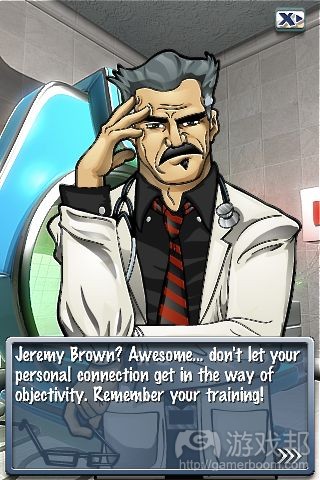分析《Dr Awesome》巧用通讯录功能的情感设计
作者:Aki Järvinen
《Dr Awesome》是款iPhone游戏,其中玩家需治疗系列迷你游戏中的病毒爆发患者(游戏邦注:和《离子射线》类似)。虽然我常称赞《离子射线》是个富有创造性的游戏设计,但《Dr Awesome》在运用玩家同联系对象的情感程度方面确实表现非常突显。这让我得以研究另一情感理论概念,也就是影响情感强度的各种元素。
《Dr Awesome》通讯录的设计特点在于通过将游戏目标融入手机通讯录,促使我们给予游戏目标更多关注。游戏设计方案并不只是让你在“救治”病人的时候动动手,其设计非常巧妙,极大强化游戏玩法和目标价值。如截图所示,病人及其同玩家的关系也将通过游戏文本内容呈现。
在我的几次体验中,接触的通常是陌生朋友或商业伙伴——所以游戏似乎是随机挑选病人。而且,我完全没碰到我常联系的密友或亲人,这些更具情感共鸣的病人或许会留到更高关卡呈现。这令人我忍不住好奇若对象是妈妈或女友,会是什么感觉。我将亲自感受,虽然游戏很快就越来越难。
这是如何和情感理论概念联系到一起?在Ortony和Clore & Collins有关情感认知结构的理论中(游戏邦注:Aki Järvinen觉得这个理论非常适合游戏设计和分析),他们定义系列影响情感强度的参数。这些参数影响情感的“基础”强度,例如玩家会更强烈,还是更温和地感受内容。下面我将例举一些元素进行分析。
《Dr Awesome》和真实感元素
我首先要谈论的元素是真实感,定义是“玩家觉得此存在情感共鸣的情境真实感有多少”。真实感存在于所有追求沉浸体验的游戏中,其中的玩家完全被转移至另一世界。
因此在很多情况下,真实感元素都通过听觉渠道呈现,旨在是消除其中的怀疑成份。此外,《Dr Awesome》还采用常出现于ARG中的其他技巧。游戏瞄准手机平台,因此还尝试通过其他技巧展现真实感元素:融入真实通讯录,设定这些联系人处在生病状态,让玩家对其进行救治,仿佛好友生死完全由玩家掌控。这个设计方案也呈现“他人命运”类型的情感世界,例如同情心。
我觉得此“通过我的专业技术拯救亲密好友性命”的隐喻令医学主题变得更富趣味,这要归功于游戏开发商Ngmoco。
这款游戏让我们获悉情感层面的设计理念,但此领域无疑还有很大探索空间。
游戏邦注:原文发布于2009年1月20日,文章叙述以当时为背景。(本文为游戏邦/gamerboom.com编译,如需转载请联系:游戏邦)
The emotional game design space of address book contacts: Case Dr. Awesome
By Aki Järvinen
Dr Awesome is an iPhone game where the players are put to treat virus outbreak patients in a series of mini-games that resemble Qix. Besides the fact that I’ve always regarded Qix as an ingenious game design, it is interesting how Dr Awesome taps into the emotional potential of one’s address book. This gives me a chance to explore another concept from emotion theory, namely the variables that affect the intensities of emotions.
The address book design feature in Dr Awesome basically tries to make us care more for the goals of the game, by embodying those goals into the contacts from the phone book. It’s not exactly a design solution that makes your hands shake as you are ‘operating’ on the patients, but it’s clever enough, and manages to put an inch more intensity into the gameplay and your valuation of the goal. As you can see from the screenshots, the patients and their relationship to you is addressed in the game’s rhetoric as well.
Based on the few goes I’ve had with the game, it’s mostly been distant friends or business contacts I’ve had to work on – so it seems it picks the patients out by random. Then again, I’ve not come across any close friends and relatives that I call or text the most, so there is a chance that these more emotionally resonant patients are left for the higher levels of the game. It makes me wonder how playing the game with, e.g., my mother or my girlfriend as the patient would make me feel. I will try to find out, even if the game gets quite hard pretty quickly.
How does this connect to concepts from emotion theory? Well, in Ortony, Clore & Collins’ theory on the cognitive structure of emotions – a theory I’ve found useful to adapt for game design and analysis purposes – they define a set of variables that affect the intensity of emotions. These are variables that affect the ‘baseline’ intensity of an emotion, i.e. whether it will be experienced as stronger or milder. I’ll be posting a series of analyses, focusing on each of the variables.
Dr Awesome and the case of the ‘Sense of reality’ variable
The first variable I’m discussing is called sense of reality, defined as ‘how much one believes that the emotion-inducing situation is real’. Sense of reality is obviously at work in all games that strive for an immersive experience where the player is transported into another world. You can read my post about Far Cry 2 through the lens of the variable.
Thus in many cases, sense of reality variable is addressed through audiovisual means, in effort to suspend disbelief. On the other hand, Dr Awesome hints at other techniques more familiar to ARGs and the like. Being developed for a phone, the game tries to address the sense of reality variable with another technique: by taking our real-life contacts, exposing them to sickness, and making the player operate on them, as if their lives would be dependent on her. This design solution also opens up the world of so-called ‘fortunes-of-others’ type of emotions, such as empathy.
I find that this metaphor of ‘game as saving the lives of my close ones with my expert surgeon skills’ is more of an entertaining aspect of the medical theme, and all credit to Ngmoco, the developer, it does not try to be anything more.
Nevertheless, it allows a peek into an emotional design space for games that could use more experimentation, definitely.(Source:mygamestudies)
上一篇:免费增值模式游戏中的极限通知机制










































 闽公网安备35020302001549号
闽公网安备35020302001549号